|
To Oaxaca
Plans
During my time of nearly one week in Mexico City, I also considered my next steps. Firstly, I figured that I would take the bus from Mexico City to Oaxaca and then from the Pacific coast would zigzag to Yucatán. I went to consult the timetables at the bus station, and learnt that buses operate about 20 times a day. I asked about the bike, no problem. That’s what I like about Mexico, there is always someone dragging something somewhere, usually some goods to sell, and transport is no problem—colectivos calmly wait until the passenger loads it on the back. Also in the Metro, nobody is reprimanded for big packages.
But then, having thought it over, I counted the remaining days and decided that I would manage to make it by bike as well. At least I would not regret passing through the barren mountainous landscape by bus in seven hours. However, the prospects of cycling from Mexico City were discouraging, so I found a convenient town 100 kilometers from Mexico City in the direction of Cuernavaca. Buses run every 15 minutes, but the terminal is 15 kilometers from the center, so it would not have solved anything, and I would still have had to struggle through the mad traffic in any case. OK, to hell with buses, I would do it alone. I remembered Cortés’s troubles when crossing the saddle between the Popocatépetl volcanoes and Iztaccíhulatl. Today Paso de Cortés is named after him, and I concluded I too could make it. It was a bit of a detour, but I had the time for it.
Getting Out of the City
In the morning, with a slight hangover after the bullfight, I went into battle. I managed to cycle the first few kilometers on a side road parallel to the main backbone route to the South. Then I had to enter the main road, as the side roads did not have bridges over the embedded roads. The shoulder was occupied at all times by colectivos and taxis, so I had to overtake them in the crowded left lane. But honestly speaking, it was not nearly as bad as on my arrival. I navigated according to the map of Mexico, which is part of the road map. Horrible, I needed to get to the side road leading to Oaxtepec. Although it was on the map, the names of the roads leading to it simply did not exist in reality, or after a few hundred meters, the street names changed (a Mexican classic). What would you expect from a map covering a city of ten million inhabitants on two A4 pages? I was caught in Xochomilco where, due to all the canals and the lake, a navigational error would represent many extra kilometers. Well, I consulted with the locals and eventually hit on it.
Then began a persistent climb and the six non-cycling days, plus various beers and wines began to manifest themselves. Maybe I was choked with the smog of Mexico City, but the fact is that I did not do well. I panted up the hills, a heart rate of 140, something I really had not experienced for a long time. I would start a better lifestyle and it would be rectified within two days. I was on the alert for both volcanoes, but they were shrouded in clouds and did not show a single flue. Perhaps on the next day things would improve.
Paso de Cortés – 3,650 Meters above Sea Level
In the morning, a navigational mistake started the day, costing me an extra 14 kilometers. The previous day, I had cycled through the intersection with the road to Paso de Cortés, so I cycled to it despite everything. On the site, I found that the road led in a completely different direction. I had to return almost to Amecameca. Well, stupidity has a price, this time it was cheap.
Then it started to get tough. There were 30 kilometers of climb to an altitude of 1,200 meters. Fortunately, only two tiny drops, so the hard-won altitude was not lost, but the ascent was steep and continuous. Popocatepetl Twist was one of the first “hit songs” of my youth, but I did not feel like singing. And the aforementioned Popocatepetl twice showed a little of its snowy peak through a break in the clouds and then again was hidden by them. I appreciated the fact that I had low gears for the mountains, this time I took advantage of them. Quite often I rested, though strangely I did not have any breathing problems, even at altitudes above 3,500 meters. Well, for 25 years of my youth I had enjoyed quality tobacco and so my lungs were not clogged by some cheap crap. I greeted the notice board with the inscription: "Paso de Cortés" with a loud shout. So, to show off, I could write in my diary 3,650 meters as the highest altitude ever reached by me on a bike!

[Paso de Cortes] A compulsory photo of the new peak record achieved.
Fine, and Now Where To?
The road on which I wanted to continue was closed due to the increased volcanic activity (apparently it is a permanent condition, that is why almost nobody drives up there). I thought about cycling through it, but when I wanted to go around the closed part on my bike, a National Park worker came to warn me not to do it. And he said that I could buy a permit to the National Park and cycle there. I had time, so I invested 25 pesos, put on jacket and leggings, as it was quite cold at that high altitude. As I was getting on the bike, a big car stopped and the people started to call "Ahoj, ahoj!" They were the first Czechs I met in Mexico, a young couple working in Mexico City and their visiting relatives. We had a nice chat, took a group photo, and I learned that I could get there out of the saddle on a bad, broken and dusty road leading into the valley where the road to Cholula was. Finally, why not, from Cholula, one could also get on to the planned route to Oaxaca, a few kilometers extra were insignificant. And there is a famous church on a pyramid in Cholula, so I would be able to see that.

[Paso de Cortes] I thought I would cross over the barrier, but a National Park worker warned me not to do it

[Paso de Cortes] The first Czechs I met in Mexico; on the right, the couple residing in Mexico, in the center, the visiting brother
I had a permit, so I cycled for about an hour on the miserable sand roads in the Park. The volcanoes did not show up anyway, so I left for Cholula. The road was really poor, very broken, rocky and with sand drifts. In addition, I often had to brake going downhill and therefore had to constantly avoid skidding in the sand. The bike was receiving knocks from the projecting stones. I cycled the whole 20 kilometers out of the saddle to lighten the bicycle as much as possible. Then, as if with a magic wand, the road changed into a super new paved road with a beautiful smooth surface. It also dropped down steeply, but that was a different story.
Cholula
Cholula has 150,000 inhabitants and today is already a suburb of Pueblo, Mexico’s third largest city. I'd had enough of big cities, so I skipped Pueblo. There was much to see in Cholula. Popokatepétl showed up in all its splendor in the morning, occasionally smoking and otherwise towering over the city from the impressive height of 5,452 meters. The previous day I had been so close and had seen nothing of its magnificence due to the clouds.
The first-class attraction of Cholula is the Tepanapa Pyramid in the center of the city, which in terms of volume is the world’s second largest pyramid. It is the widest pyramid in the world. From a distance it looks like a strangely regular wooded hill, but there are quite a lot of those around. Archaeologists have dug more than 8 kilometers of tunnels into the pyramid and uncovered a number of the older structures on which the pyramid was built. The 800-meter tunnel leading through the base of the pyramid to the archaeological site with Aztec temples and altars is accessible to tourists. Correction – at the present time it had already not been open for 11 months, as part of the tunnel had collapsed. Earnest Mexicans therefore made the excavations available free of charge. Including the tunnel, the fee was 41 pesos.

[Cholula] Popokatepétl towers over the city as its sovereign ruler

[Cholula] The town is packed with churches
The Spaniards built the church of Santuario de Nuestra Seòora de los Remedios on the top of the pyramid, although at the time of construction they probably did not even know that they were building on a pyramid. Today, there are 39 churches in Cholula. However, Cortés originally commanded the construction of 365, one for every day of the year. Other beautiful churches are situated around Zócalo, especially Ex-Convento de San Gabriel and the Arabian-looking Capilla Real. I devoted over three hours to them, setting out on the road exhilarated after 11 a.m.

[Cholula] The Spaniards built the church of Santuario de Nuestra Seòora de los Remedios on the Tepanapa pyramid; below is one of the Aztec altars

[Cholula] Tepanapa pyramid - Aztec head near one of the altars

[Cholula] Cops get ready for action; fortunately they are not after me, I would have had to zigzag to get away
The previous day, the bike had got very dirty from the sand on the dusty road, and I felt sorry for the new chain which I had replaced in Mexico City. I could not wash it with WD in the hotel so I was worried. I cycled around the autolavado. The boy there had a good WAP so I washed it thoroughly and then oiled everything. I wanted to pay him, but he said, "For amigo it is free of charge!" Good. But almost everyone in Mexico has a car wash. Especially in villages, just a piece of turf and a barrel of water are needed and you can go into business. No ecological liquidation of waste water, it flows directly into the ditch beside the road. This was a similar case, although he had a water supply, electricity and the WAP. Where the water flowed to was not his problem.
The Most Beautiful Church
In Acatepec there is one of the most beautiful churches I have ever seen. It combines the elements of Baroque and folk architecture. The façade is covered in brightly colored glazed tiles, the interior is richly gilded with naivistic figures of the saints and other faces on the walls. This blend of cultures and styles has created a new quality and made a huge impression on me. On the rest of my very easy cycle, I kept looking back at the still beautifully visible Popokatepétl, saw the saddle between the two volcanoes, through which I had passed the previous day and was very proud of myself for the accomplishment. My total wellbeing was probably also visible externally, as drivers honked at me, waved from their car windows, workers along the paths called “Olé, olé, amigo,” cops waved, I saluted them, glorious as at a Peace Rally (readers born later will forgive me).

[Acatepec] Templo de San Francisco

[Acatepec] Colorful mosaic facade of the Templo de San Francisco

[Acatepec] Detail of the altar in the Templo de San Francisco

[Acatepec] Detail of the decoration on the side walls of the Templo de San Francisco
After about 60 kilometers, I stopped in Izúcar de Matamoros. The town has several extremely beautiful churches, but the guidebook does not mention them at all. To get into a guidebook, something more is needed; there are magnificent churches everywhere. I arrived early, so I finally had a haircut, that is, my head was shaved down to the skull for a reasonable 30 pesos. After all, I was in the tropics and as I progressed southwards, the temperature was rising, so why should the rest of my hair be sweating all the time?

[Atlixco] I said goodbye to Popokatepétl, who was happily puffing smoke

[Izucar de Matamoros] Church at the entrance to the town

[Izucar de Matamoros] The interior of the Exconvento Santo Domingo Church
A long hilly (mountainous, to the Czechs) section began, where distances between individual poor villages are up to 5O kilometers and there is no possibility of buying food or drink elsewhere. However, cycling was amazing. Little traffic, mostly a quality surface, reasonable climbs, no need to stomp on the pedals, so I could cycle pretty rhythmically, albeit in lower gears. However, the cycling pleasure was spoilt by the heat. Even before 2 p.m I had to lie down for a half-hour nap in the shade of a giant notice board announcing how much the State of Puebla had invested in repairing the local roads. Perhaps it was due to the massive lunch in Tehutzingo—the chicken soup (containing at least a quarter of a chicken) and the fantastic wheat tortillas (de harina) on which I had over-gorged myself.

[Near Izucar de Matamoros] Great surface, minimal traffic, beautiful hills in upside-down style, but no extremes - sheer cycling splendor

[Near Tehutzingo] Country cemetery
After 90 kilometers, I stopped in Acatlán. There was one posh hotel for 350 pesos, but I would have had to carry my things up to the third floor. Keep it, darlings! 50 meters further on was a classic motel, where I cycled straight into the room from the courtyard, for the price of 130 pesos. They had clotheslines on the roof, so I washed my smelly outfit and T-shirt. They were dry two hours later. Along the road, I had found a nice towel and a piece of wrapping foil, so I was able to clean the chain and rollers, which were dirty from the dust road, without dropping a single milliliter of oil on the courtyard tiles. Between me and you, even if I had messed up the place with WD, they would not have minded.

[Acatlán] Mass is celebrated in the church on the square, a lady sings beautifully, the moon shines above, and behind is a funfair with roundabouts - indeed the real, authentic Mexico
There are always some celebrations going on in Mexico. The square in Acatlán was crowded with stalls and funfair attractions, but they operated just for two hours and then nobody was interested, so they closed down. On stage, an impersonator of local pop music stars performed for more than an hour, according to the response of the audience, very well. He also told lewd jokes. I did not understand everything, but the caballeros laughed a lot and the mujeres, with their downy lips, were shyly simpering, while the muchachas and muchachos were gazing at him uncomprehendingly open-mouthed. He also did the very incorrect scene, but apparently popular in Mexico (I had already seen it in Toluca), comparing the intelligence of girls and boys. He invited a young boy and a girl, a head taller than him, on stage and asked them questions – trivial ones of the lad, nonsense of the girl, so that the little boy always won. In conclusion, the result was to be determined by the construction of a pyramid of cubes. The girl was more adept, but he always inconspicuously kicked at her construction and destroyed it. The audience had a great time, feminists and equal rights advocates would probably have had a stroke on the spot. I went to bed after 11 p.m., but it did not seem at all that this was nearing the end. At 5 a.m. I was awoken by ringing church bells followed by a volley of bangs, perhaps another day of celebrations was starting.
I was entertained by two cops who were hanging around in bulletproof vests and with the essential guns. One of them had a mask over his face, just slits for the eyes. At any moment he was going to be approached by some local who would pat him on the shoulder, and say: “How are you, José?” Camouflage was indeed necessary.
The next day, I cycled to the 60-kilometer distant Huajuapan de León. It did not make any sense to continue, the next large town with accommodation was over 90 kilometers away. Anyway, I'd had enough, it had almost always been uphill and the harsh sun in particular had given me a pretty hard time. I put the cover back on my nose, it had been nearly sunburned the previous day. But the scenery was beautiful, a panorama of impressive mountain ranges. In the North-East I saw a snowy peak of a really big mountain, although I could not identify which mountain it was on the map.

[El Tecomate] The donkey does not care about the beauty of the landscape; "I cannot feed on it", he thinks

[El Tecomate] Mountainous, green landscape, made special by the cacti

[Petlalcingo] A town beneath the mountains can easily produce its own smog
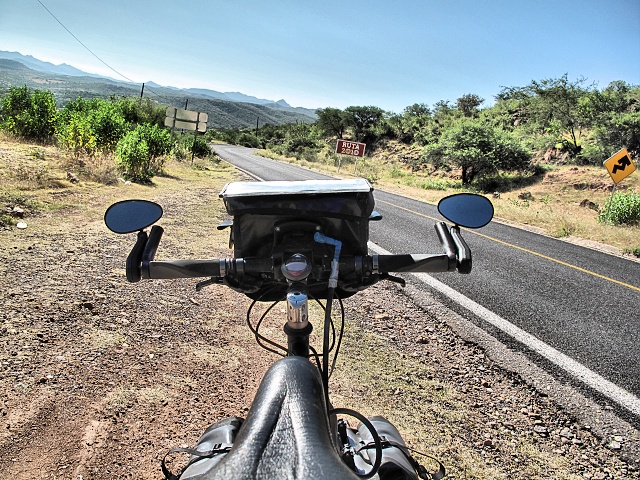
[Petlalcingo] Two mirrors on the bike are really ingenious, I know about everything happening behind me
The further South, the greater the poverty, beggars and filth. Villages along the way were obviously poor, the cities also nothing special. After crossing the border between the states of Puebla and Oaxaca, the road surface deteriorated significantly, consisting of gravel embedded in asphalt, lots of holes, broken edges. In Huajuapan, there was a large stage in front of the church on which a gigantic church service was to take place later. Apart from the novices of the local order, the congregation was formed exclusively of young people.

[Huajuapan de Leon] Indian women watch the church ceremony from the outside, they would not be allowed in, neither would I be, and I even took the bows out of my hair to be inconspicuous

[Huajuapan de Leon] Church fete
Mexican towns usually lie in the valleys, so every morning began with several kilometers of climbing. The mornings are cold there in the mountains, people wear jackets, hats and, particularly pampered individuals, also gloves. So at least the climb warmed me up to a proper functioning temperature.

[Huajuapan de Leon] This pretty cross was not far out of the town

[Near Huajuapan] Morning climb, Santiago Cacalostepec in the background
Chased by the Police
The road from Huajuapan was covered by two-member crews of police patrols and therefore it was clear that something was going to happen. And happen it did. I had finally reached a pleasant descent, when a Federal Police car raced past me. They turned the car around, stuck behind my back and began to honk and call through the loudspeaker “la bicicleta pronto, blah blah blah.” Even though I did not understand everything, I knew that I had to get out of the road. But there was nowhere to go, the road ended with a white line and next to it was a pretty steep slope, where I was not willing to move despite the urging of the police. For more than a kilometer, they shouted and honked, while I rode on, until the intersection to Santa Maria Tutla appeared, where I stopped. There were two other police officers there, but no one said anything to me. The police car turned around and went back up the hill. In a moment everything was clear: a motor race had started and for nearly two hours prevented me from cycling on the road.

[Santa Maria Tutla] Mountain village

[Santa Maria Tutla] Car race – the Porsche team raced by at breakneck speed
I wanted to cover over 90 kilometers that day, so I suspected that I would be battling against time. The worst thing is that I never knew how hilly the road ahead would be. I did not manage to find any map that indicated the altitude ratios and so it was a lottery bet. This time, unfortunately, it was an almost uninterrupted climb of 60 kilometers to the altitude of 2,500 meters. But the landscape was breathtaking and I had time to relish the views properly during the slow uphill ride.

[San Juan Teposcolula] Due to frequent earthquakes, the landscape is somewhat eroded

[Yanhutlan] Churches are solid here, constructed of huge stone blocks, otherwise they would not endure the frequent earthquakes
At 5 p.m. I still had 30 kilometers ahead of me, and, if it were to continue like this, I would definitely not have made it by 18:30 when the visibility was fading. So I interviewed a taxi driver who was parked beside the road and learned that the road went just a little further uphill and thereafter was downhill all the way. I easily arrived in Nochixtlán still in daylight and could tour the hotels in the center and choose the most suitable one. I even managed to go to the market to buy vegetables, bread and cottage cheese for breakfast. This is what I really liked there, I ate almost no industrially produced food. Vegetables on the market were fresh, tasted like vegetables and not like the sterile substitutes without taste and smell sold in supermarkets. On the markets it was always possible to buy several kinds of local cheese, they gave me a taste and I then bought my 15 to 2O dkg for breakfast. I also nearly eliminated yogurts, buying cottage cheese, stirring in the jelly and licking my lips till noon. Well, and speaking about markets, I usually ate at a stall where there were many people. There are almost no classic restaurants in smaller towns (up to 100,000 inhabitants) as, if it is not a tourist town, nobody goes there.

[Nochixtlán] Sunset over the Zócalo

[Nochixtlán] The local church is the center of all events, it is even adjoined by a small football pitch

[Nochixtlán] Present-day Mexico in a nutshell: fervent religion, the cult of the Virgin Mary, combined with amazingly advanced telecommunications, the Internet is literally everywhere
Breaking the Rules
In the morning I studied the map, and was tempted by the almost direct toll road (cuota), while the free road (libre) meandered like a worm and was about 20 kilometers longer. I read on the Internet that although cycling on a cuota is strictly prohibited, long-distance cyclists are often tolerated. I hate breaking the rules, but this time I attempted it. Despite the “no cycling” sign, I went on to the paid road and flew ahead on the verge which was more than a meter wide. It was Sunday, minimal traffic, I met no cops along the way. I did not enjoy the first 50 kilometers. After all, I was violating the regulations, then came the toll gate. I passed by the closed gate in the right lane, where there was no cashier, but it was guarded by soldiers. I politely greeted them, they replied and waved, and I was off the toll road. After about 150 meters, I pulled the bike through two ditches and was back on the paid road. And I stopped worrying. I saved about 20 kilometers and probably several hundreds of meters in altitude, but I missed the contact with the landscape, passing through the villages. I only did not miss the constant struggle with the dogs. It was fine for once, but not really enjoyable.

[Near Huitzo] I tried the cuota, paid highway; road signs prohibit cycling, but nobody objected for the entire 80 km
Oaxaca
After an approximately 10-kilometer long sleazy suburb, a dirty and broken road and dangerous traffic, a neat and well-maintained colonial city center with imposing houses and churches constructed from massive stone blocks suddenly appeared. And also a lot of tourists. I found accommodation as usual in the center, tasted the local specialty, chapulines –roasted grasshoppers – good, but parts of the wings and legs are unchewable and remain in the mouth. Then only fun followed, there was always something happening on Sundays. On the square in front of the cathedral I saw folk dances and then wrestlers “fighting” in the ring. The two-week celebrations of the famous Seòor el Rayo Christ statue were ending. The cathedral was heavily decorated with flowers and Mass was being celebrated almost continuously. Locals waited in line for about 20 minutes to be able to kiss and touch the sacred garments. Items were being offered for sale everywhere, people were always eating something and after dark there was a massive fireworks' display, which was the cherry on top to crown a great Sunday.

[Oaxaca] The famous statue of Christ, Seòor del Rayo, dollar bills hang on red fabric at approximately the level of Christ’s waist

[Oaxaca] Center, Hidalgo Street leading to Zócalo

[Oaxaca] A street corner in the center

[Oaxaca] The South side of Zócalo was occupied by the protesting poor and homeless; under the arcades behind the banners, entire families with small children live in unimaginable (to us) conditions

[Oaxaca] Palacio de Gobierno serves as an exhibition hall and a museum with many interactive exhibitions

[Oaxaca] Palacio de Gobierno - fresco dedicated to Benito Juárez and his wife Margarita Maza, they got married in one of the local churches

[Oaxaca] Folk dances performed in front of the Cathedral, it is very difficult, notice that all of them are floating in the air

[Oaxaca] The youngest dancer took it as seriously as his colleagues

[Oaxaca] Mother and daughter rushing to the folklore parade

[Oaxaca] Templo de Santo Domingo - center of the Dominican Order in Mexico

[Oaxaca] Templo de Santo Domingo - richly gilded altar

[Oaxaca] Templo de Santo Domingo - detail of ceiling decoration

[Oaxaca] The approaching Day of the Dead cannot be overlooked, decoration to the entrance of a travel agency

[Oaxaca] The living cannot escape the Day of the Dead, only those who are actually dead probably do not care

[Oaxaca] Decorative embellishment for Día de Muertos
Monte Albán
“White Mountain” rises 500 vertical meters above Oaxaca, affording beautiful panoramic views in all directions, so I could also observe the landscape in the direction from which I had come. The beginnings of the settlement date back to 500 BC. Gradually, a vast complex of palaces, pyramids, temples, tombs, and pelota courses was built on the mountain. The local civilization was very advanced. The first written script and written calendar in Mexico appeared there. Astronomical knowledge was advanced. For example, there were visors in the palaces through which the sun shone only at the equinox. The complex also includes an astronomical observatory in an unusual arrow ground plan, diverted 45 degrees from the axis of the main square. The whole extensive complex has excellent acoustics, so worship and celebrations could be watched by thousands of people. Between 700 AD and 950 AD, the site was abandoned and began to deteriorate. I was shocked by the preserved reliefs of Danzantes (dancers) in the local museum—they are images of prisoners with cut-off genitalia to demonstrate the power of Monte Albán. All the local civilizations, from our point of view, were very cruel. It is really surprising that people with such a history could not have defeated a few Spanish invaders.

[Monte Alban] Morning view of Oaxaca shrouded in fog

[Monte Alban] Gran Plaza in the foreground, behind it Plataforma Norte

[Monte Alban] Stones in front of Observatorio

[Monte Alban] Vista from Plataforma Norte to Gran Plaza and Plataforma Sur

[Monte Alban] Relief of one of the Danzantes (dancers) in the museum: prisoners depicted with their genitalia cut off, to demonstrate the power of Monte Albán
More Distant Plan
The end of my roaming was slowly approaching and I needed to clarify how to proceed. There are three possible roads leading to the Pacific, supposedly the best is to go to Puerto Escondido (I was told this in the bike store specializing in cycling trips), but this is about 350 kilometers longer than the direct road to Tehuantepec. I counted the remaining kilometers on the shortest route and ended up with 2000 kilometers. This was just the right distance for the time of less than a month remaining to me. So I would forget about the route along the Pacific shore and take the shortest route.

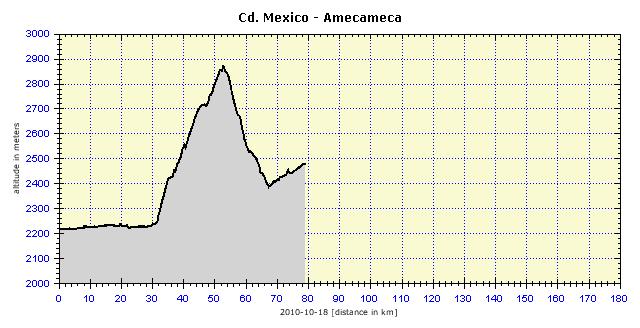
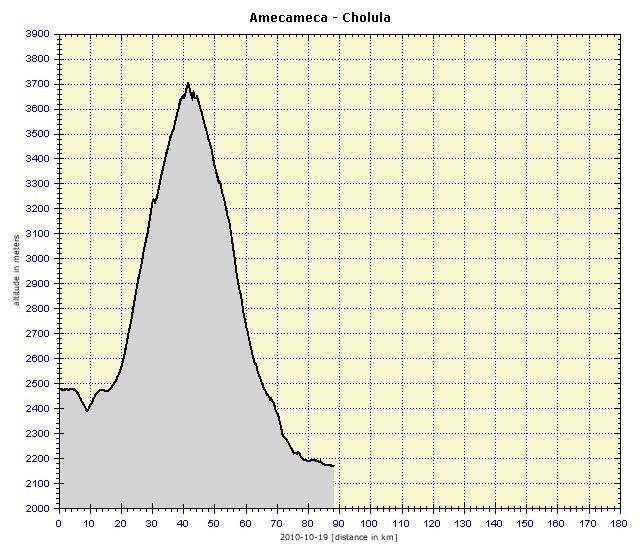
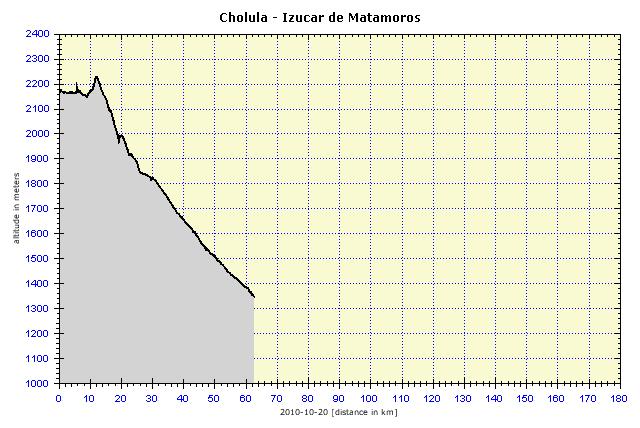
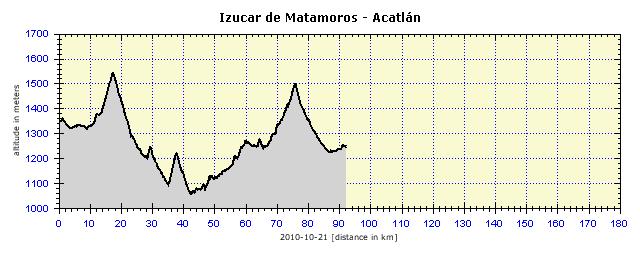
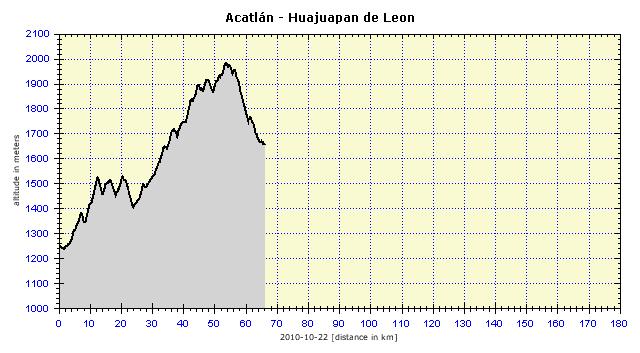
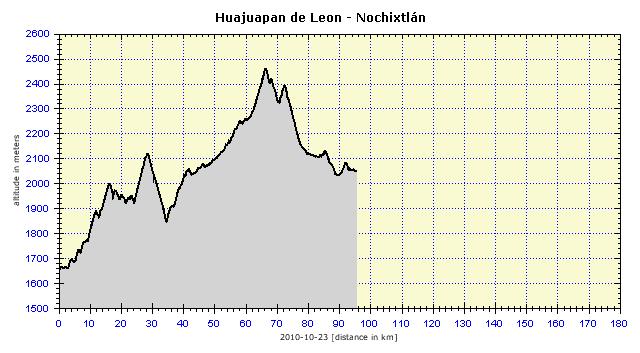

|





































































